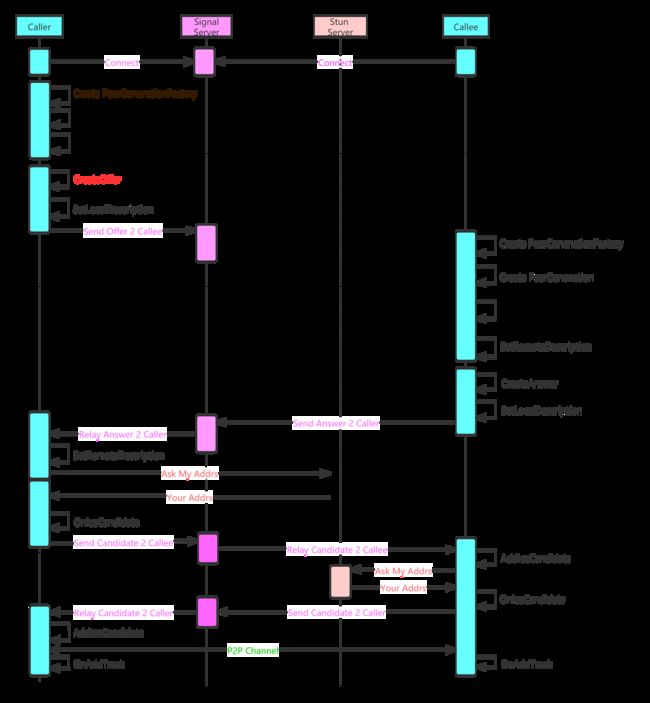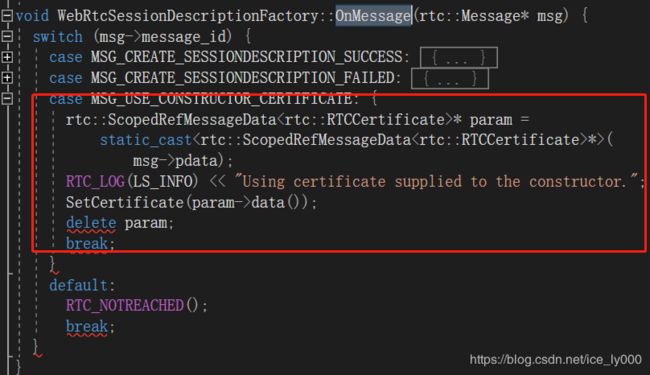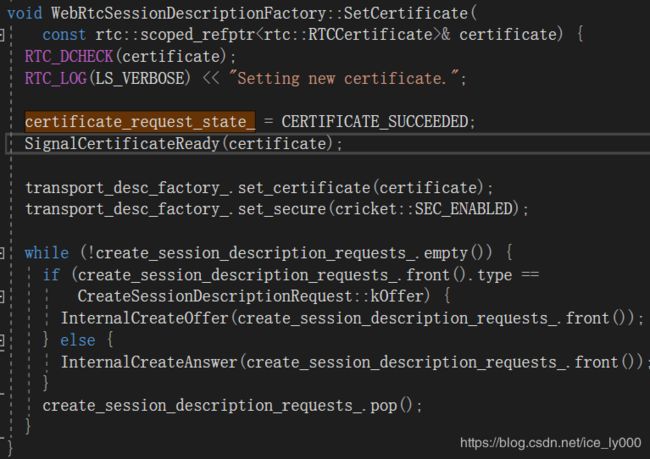WebRTC源码分析-呼叫建立过程之五(创建Offer,CreateOffer,上篇)
目录
- 1. 引言
- 2 CreateOffer声明 && 两个参数
- 2.1 CreateOffer声明
- 2.2 参数CreateSessionDescriptionObserver
- 2.3 参数RTCOfferAnswerOptions
- 3 PeerConnection::CreateOffer
- 3.1 PeerConnection::DoCreateOffer
- 3.1.1 PeerConnection::PostCreateSessionDescriptionFailure
- 3.1.2 PeerConnection::HandleLegacyOfferOptions
- 3.1.3 PeerConnection::GetOptionsForOffer
- 3.1.3.1 MediaSessionOptions
- 3.1.3.2 ExtractSharedMediaSessionOptions
- 3.1.3.3 GetOptionsForUnifiedPlanOffer
- 3.2 WebRtcSessionDescriptionFactory::CreateOffer
- 3.2.1 WebRtcSessionDescriptionFactory::InternalCreateOffer
- 3.2.1.1 MediaSessionDescriptionFactory::CreateOffer
- 4 总结
- 4.1 CreateOffer总体流程图
- 4.2 重要结构体 && 类的关系图
- 4.2.1 信息——MediaSessionOptions
- 4.2.2 目标——JsepSessionDescription
1. 引言
创建完PeerConnectionFactory 和 PeerConnection这两个API层的操盘对象之后;紧接着需要初始化本地的媒体,也即创建本地的音频轨、视频轨、数据通道,并将这些本地的媒体轨道添加到PeerConnection对象中。然后即可调用PeerConnection::CreateOffer()创建本地SDP对象。
本文将详细描述PeerConnection::CreateOffer()过程,相关的知识点。如下图
2 CreateOffer声明 && 两个参数
2.1 CreateOffer声明
void CreateOffer(CreateSessionDescriptionObserver* observer,
const RTCOfferAnswerOptions& options) override;
2.2 参数CreateSessionDescriptionObserver
class RTC_EXPORT CreateSessionDescriptionObserver
: public rtc::RefCountInterface {
public:
virtual void OnSuccess(SessionDescriptionInterface* desc) = 0;
virtual void OnFailure(RTCError error);
virtual void OnFailure(const std::string& error);
protected:
~CreateSessionDescriptionObserver() override = default;
};
注意:CreateSessionDescriptionObserver只是一个接口,没有具体实现。一般用户层需要继承,并实现CreateSessionDescriptionObserver的方法,以便用户侧感知CreateOffer状态。
另外,WebRTC内部提供了两个实现了CreateSessionDescriptionObserver接口的类,ImplicitCreateSessionDescriptionObserver && CreateSessionDescriptionObserverOperationWrapper。在后续分析过程中再来聊聊这两个实现所起的作用。
2.3 参数RTCOfferAnswerOptions
RTCOfferAnswerOptions源码如下(省略了构造函数):
struct RTCOfferAnswerOptions {
static const int kUndefined = -1;
static const int kMaxOfferToReceiveMedia = 1;
// The default value for constraint offerToReceiveX:true.
static const int kOfferToReceiveMediaTrue = 1;
// These options are left as backwards compatibility for clients who need
// "Plan B" semantics. Clients who have switched to "Unified Plan" semantics
// should use the RtpTransceiver API (AddTransceiver) instead.
//
// offer_to_receive_X set to 1 will cause a media description to be
// generated in the offer, even if no tracks of that type have been added.
// Values greater than 1 are treated the same.
//
// If set to 0, the generated directional attribute will not include the
// "recv" direction (meaning it will be "sendonly" or "inactive".
int offer_to_receive_video = kUndefined;
int offer_to_receive_audio = kUndefined;
bool voice_activity_detection = true;
bool ice_restart = false;
// If true, will offer to BUNDLE audio/video/data together. Not to be
// confused with RTCP mux (multiplexing RTP and RTCP together).
bool use_rtp_mux = true;
// If true, "a=packetization: raw" attribute will be offered
// in the SDP for all video payload and accepted in the answer if offered.
bool raw_packetization_for_video = false;
// This will apply to all video tracks with a Plan B SDP offer/answer.
int num_simulcast_layers = 1;
// If true: Use SDP format from draft-ietf-mmusic-scdp-sdp-03
// If false: Use SDP format from draft-ietf-mmusic-sdp-sdp-26 or later
bool use_obsolete_sctp_sdp = false;
};
RTCOfferAnswerOptions提供的参数,英文注释写得非常清楚,此处就不多赘述。特别值得注意的是use_rtp_mux 默认为真,使得所有媒体都集合到一个Bundle group,复用底层的同一个传输通道DTLS Transport。
3 PeerConnection::CreateOffer
接下来,我们来抽丝剥茧,一步步分析CreateOffer的整个流程。
void PeerConnection::CreateOffer(CreateSessionDescriptionObserver* observer,
const RTCOfferAnswerOptions& options) {
// 1. 信令线程执行
RTC_DCHECK_RUN_ON(signaling_thread());
// 2. 排队执行
// Chain this operation. If asynchronous operations are pending on the chain,
// this operation will be queued to be invoked, otherwise the contents of the
// lambda will execute immediately.
operations_chain_->ChainOperation(
[this_weak_ptr = weak_ptr_factory_.GetWeakPtr(),
observer_refptr =
rtc::scoped_refptr<CreateSessionDescriptionObserver>(observer),
options](std::function<void()> operations_chain_callback) {
// 2.1 如果this_weak_ptr为空,意味着当前PC已经不存在,会话被关闭
// Abort early if |this_weak_ptr| is no longer valid.
if (!this_weak_ptr) {
// 2.1.1 通知用户侧CreateOffer失败及失败原因
observer_refptr->OnFailure(
RTCError(RTCErrorType::INTERNAL_ERROR,
"CreateOffer failed because the session was shut down"));
// 2.1.2 执行操作结束的回调,通知执行下一个Operation
operations_chain_callback();
return;
}
// 2.2 执行真正的DoCreateOffer
// The operation completes asynchronously when the wrapper is invoked.
// 2.2.1 创建入参Observer的一个Wrapper对象,该对象还封装了操作回调函数的指针,
// 使得CreatOffer结束后,能够调用回调函数,通知执行下一个Operation,同时能够通知
// 用户侧本次CreatOffer的结果。
rtc::scoped_refptr<CreateSessionDescriptionObserverOperationWrapper>
observer_wrapper(new rtc::RefCountedObject<
CreateSessionDescriptionObserverOperationWrapper>(
std::move(observer_refptr),
std::move(operations_chain_callback)));
// 2.2.2 调用DoCreateOffer进一步去创建Offer
this_weak_ptr->DoCreateOffer(options, observer_wrapper);
});
}
CreateOffer方法执行过程是比较明朗的,也有必要将涉及的基本观念、设计方式交代下:
- WebRTC中将CreateOffer、CreateAnswer、SetLocalDescription、SetRemoteDescription、AddIceCandidate这5个与SDP会话相关的API认为是一个Operation,这些Operation必须是挨个执行,不能乱序,不能同时有两个交互执行。因此,设计了一套操作链的接口,由OperationsChain类提供此功能。当链入一个操作时,如果队列中没有其他操作,那么该操作会被立马执行;若是操作链中存在操作,那么本操作就入队操作链,等待上一个操作执行完成之后,以回调的形式(即上述代码中的operations_chain_callback回调方法)来告知执行下一步操作。具体实现可见文章:WebRTC源码分析——操作链实现OperationsChain
- CreateSessionDescriptionObserverOperationWrapper相当于一个封装了 "Offer操作结果回调 + 操作链操作完成回调"的一个对象,一直沿着CreateOffer调用链往下传,直到能够判断是否能成功创建Offer的地方,创建Offer这个操作完成的地方,然后去触发其承载的回调函数,以便告知上层操作结果,然后触发下一个操作。具体见源码
```cpp
// Wraps a CreateSessionDescriptionObserver and an OperationsChain operation
// complete callback. When the observer is invoked, the wrapped observer is
// invoked followed by invoking the completion callback.
class CreateSessionDescriptionObserverOperationWrapper
: public CreateSessionDescriptionObserver {
public:
CreateSessionDescriptionObserverOperationWrapper(
rtc::scoped_refptr<CreateSessionDescriptionObserver> observer,
std::function<void()> operation_complete_callback)
: observer_(std::move(observer)),
operation_complete_callback_(std::move(operation_complete_callback)) {
RTC_DCHECK(observer_);
}
~CreateSessionDescriptionObserverOperationWrapper() override {
RTC_DCHECK(was_called_);
}
void OnSuccess(SessionDescriptionInterface* desc) override {
RTC_DCHECK(!was_called_);
#ifdef RTC_DCHECK_IS_ON
was_called_ = true;
#endif // RTC_DCHECK_IS_ON
// Completing the operation before invoking the observer allows the observer
// to execute SetLocalDescription() without delay.
operation_complete_callback_();
observer_->OnSuccess(desc);
}
void OnFailure(RTCError error) override {
RTC_DCHECK(!was_called_);
#ifdef RTC_DCHECK_IS_ON
was_called_ = true;
#endif // RTC_DCHECK_IS_ON
operation_complete_callback_();
observer_->OnFailure(std::move(error));
}
private:
#ifdef RTC_DCHECK_IS_ON
bool was_called_ = false;
#endif // RTC_DCHECK_IS_ON
rtc::scoped_refptr<CreateSessionDescriptionObserver> observer_;
std::function<void()> operation_complete_callback_;
};
- rtc::WeakPtrFactory
weak_ptr_factory_:在构造PeerConnection时,传入了this指针。当从weak_ptr_factory_获取弱指针this_weak_ptr不存在时,意味着PC已经不存在了,也即当前会话已被关闭。这样的功能是由rtc::WeakPtrFactory && WeakPtr带来的,详见 WebRTC源码分析——弱指针WeakPtrFactory && WeakPtr。要注意的是weak_ptr_factory_必须声明在PC的最后,这样是为了:
// |weak_ptr_factory_| must be declared last to make sure all WeakPtr's are
// invalidated before any other members are destroyed.
3.1 PeerConnection::DoCreateOffer
void PeerConnection::DoCreateOffer(
const RTCOfferAnswerOptions& options,
rtc::scoped_refptr<CreateSessionDescriptionObserver> observer) {
// 1. 状态判断
// 1.1 运行在信令线程
RTC_DCHECK_RUN_ON(signaling_thread());
TRACE_EVENT0("webrtc", "PeerConnection::DoCreateOffer");
// 1.2 观察者不能为空
if (!observer) {
RTC_LOG(LS_ERROR) << "CreateOffer - observer is NULL.";
return;
}
// 1.3 PC的信令状态不能是已关闭状态——kClose
// 信令状态: enum SignalingState {
// kStable,
// kHaveLocalOffer,
// kHaveLocalPrAnswer,
// kHaveRemoteOffer,
// kHaveRemotePrAnswer,
// kClosed,};
// PC创建时默认为kStable状态,只有PC调用Close方法时,会使得其处于kClosed状态
if (IsClosed()) {
std::string error = "CreateOffer called when PeerConnection is closed.";
RTC_LOG(LS_ERROR) << error;
PostCreateSessionDescriptionFailure(
observer, RTCError(RTCErrorType::INVALID_STATE, std::move(error)));
return;
}
// 1.4 会话状态判断
// If a session error has occurred the PeerConnection is in a possibly
// inconsistent state so fail right away.
if (session_error() != SessionError::kNone) {
std::string error_message = GetSessionErrorMsg();
RTC_LOG(LS_ERROR) << "CreateOffer: " << error_message;
PostCreateSessionDescriptionFailure(
observer,
RTCError(RTCErrorType::INTERNAL_ERROR, std::move(error_message)));
return;
}
// 1.5 验证options的合法性
// 实际就是判断offer_to_receive_audio && offer_to_receive_video
// 这两个参数是否合法(取值在kUndefined~kMaxOfferToReceiveMedia之间)
// 默认二者皆为kUndefined。
if (!ValidateOfferAnswerOptions(options)) {
std::string error = "CreateOffer called with invalid options.";
RTC_LOG(LS_ERROR) << error;
PostCreateSessionDescriptionFailure(
observer, RTCError(RTCErrorType::INVALID_PARAMETER, std::move(error)));
return;
}
// 1.6 如果是Unified Plan,处理options中遗留的字段
// Legacy handling for offer_to_receive_audio and offer_to_receive_video.
// Specified in WebRTC section 4.4.3.2 "Legacy configuration extensions".
if (IsUnifiedPlan()) {
RTCError error = HandleLegacyOfferOptions(options);
if (!error.ok()) {
PostCreateSessionDescriptionFailure(observer, std::move(error));
return;
}
}
// 2 获取MediaSessionOptions信息,为创建Offer提供信息
// MediaSessionOptions包含了创建Offer时对每个mline都适用的公共规则,并且为每个mLine
// 都准备了一个MediaDescriptionOptions
cricket::MediaSessionOptions session_options;
GetOptionsForOffer(options, &session_options);
// 3 执行WebRtcSessionDescriptionFactory::CreateOffer来创建Offer
webrtc_session_desc_factory_->CreateOffer(observer, options, session_options);
}
DoCreateOffer大致分两个部分,第一个部分是对入参和当前状态的一些判断(如源码所示共6点),若这些条件和状态不对,则PostCreateSessionDescriptionFailure方法将错误信息post出去,并且不再继续创建Offer的后续动作;第二个部分是获取MediaSessionOptions信息,然后调用WebRtcSessionDescriptionFactory::CreateOffer来实际创建Offer.
3.1.1 PeerConnection::PostCreateSessionDescriptionFailure
void PeerConnection::PostCreateSessionDescriptionFailure(
CreateSessionDescriptionObserver* observer,
RTCError error) {
RTC_DCHECK(!error.ok());
CreateSessionDescriptionMsg* msg = new CreateSessionDescriptionMsg(observer);
msg->error = std::move(error);
signaling_thread()->Post(RTC_FROM_HERE, this,
MSG_CREATE_SESSIONDESCRIPTION_FAILED, msg);
}
struct CreateSessionDescriptionMsg : public rtc::MessageData {
explicit CreateSessionDescriptionMsg(
webrtc::CreateSessionDescriptionObserver* observer)
: observer(observer) {}
rtc::scoped_refptr<webrtc::CreateSessionDescriptionObserver> observer;
RTCError error;
};
我们可以看到实际上,PostCreateSessionDescriptionFailure方法是将observer,error打包到自定义的消息对象CreateSessionDescriptionMsg中,该消息继承于MessageData,从而可以通过rtc::Thread的Post方法投递到信令线程的消息队列中。注意:投递时,消息的接收方是this,也即PC对象;另外MessageData和MSG_CREATE_SESSIONDESCRIPTION_FAILED在Thread::Post方法中进一步被封装为rtc::Message对象,前者成为其pdata成员,后者成为其message_id成员。在之前的文章中我们提到过PC是继承了MessageHandler的,投递出去的消息,将在PC::OnMessage方法中得到处理:

前文,我们分析过创建Offer这个过程不论成功与否,最终都需要进行两个操作:一个是通知用户侧传入的Observer获知创建Offer是否成功,一个是调用操作链的回调函数,告知本次操作已完毕,进而执行下一个操作。上图红线框中的代码正是做了这点:通过执行CreateSessionDescriptionObserverOperationWrapper::OnFailure方法(如后文第4部分所示)。
3.1.2 PeerConnection::HandleLegacyOfferOptions
RTCError PeerConnection::HandleLegacyOfferOptions(
const RTCOfferAnswerOptions& options) {
RTC_DCHECK(IsUnifiedPlan());
// 1. 处理音频(offer_to_receive_audio)
// 1.1 为0,不接受音频流,遍历移除
if (options.offer_to_receive_audio == 0) {
RemoveRecvDirectionFromReceivingTransceiversOfType(
cricket::MEDIA_TYPE_AUDIO);
// 1.2 为1,接受音频流,遍历添加
} else if (options.offer_to_receive_audio == 1) {
AddUpToOneReceivingTransceiverOfType(cricket::MEDIA_TYPE_AUDIO);
// 1.3 >1,参数错误
} else if (options.offer_to_receive_audio > 1) {
LOG_AND_RETURN_ERROR(RTCErrorType::UNSUPPORTED_PARAMETER,
"offer_to_receive_audio > 1 is not supported.");
}
// 2. 处理视频(offer_to_receive_video)
// 2.1 为0,不接受视频流,遍历移除
if (options.offer_to_receive_video == 0) {
RemoveRecvDirectionFromReceivingTransceiversOfType(
cricket::MEDIA_TYPE_VIDEO);
// 2.2 为1,接受视频流,遍历添加
} else if (options.offer_to_receive_video == 1) {
AddUpToOneReceivingTransceiverOfType(cricket::MEDIA_TYPE_VIDEO);
// 2.3 >1,参数错误
} else if (options.offer_to_receive_video > 1) {
LOG_AND_RETURN_ERROR(RTCErrorType::UNSUPPORTED_PARAMETER,
"offer_to_receive_video > 1 is not supported.");
}
return RTCError::OK();
}
当采用Unified Plan时,需要针对options的offer_to_receive_audio和offer_to_receive_audio进行处理,当offer_to_receive_xxx为0表示本端不接收对应的流,offer_to_receive_xxx为1表示接收。需要对PC所持有的transceivers_进行遍历处理。
1)当不接收流时RemoveRecvDirectionFromReceivingTransceiversOfType进行处理:
void PeerConnection::RemoveRecvDirectionFromReceivingTransceiversOfType(
cricket::MediaType media_type) {
// 通过GetReceivingTransceiversOfType遍历transceivers_,获取所有对应媒体类型的、
// 传输方向包含recv的的Transceivers。然后再遍历这些符合条件的Transceivers。
for (const auto& transceiver : GetReceivingTransceiversOfType(media_type)) {
// 通过RtpTransceiverDirectionWithRecvSet方法获取新方向,新的方向中应保留
// 旧方向中的Send(旧方向中若存在的话)。
RtpTransceiverDirection new_direction =
RtpTransceiverDirectionWithRecvSet(transceiver->direction(), false);
// 若新方向与旧方向是不一致的,因此,有改变,调用transceiver的set_direction
// 设置为新方向。
if (new_direction != transceiver->direction()) {
// 打印日志
RTC_LOG(LS_INFO) << "Changing " << cricket::MediaTypeToString(media_type)
<< " transceiver (MID="
<< transceiver->mid().value_or("" ) << ") from "
<< RtpTransceiverDirectionToString(
transceiver->direction())
<< " to "
<< RtpTransceiverDirectionToString(new_direction)
<< " since CreateOffer specified offer_to_receive=0";
// 更改方向Transceiver方向
transceiver->internal()->set_direction(new_direction);
}
}
}
// Sets the intended direction for this transceiver. Intended to be used
// internally over SetDirection since this does not trigger a negotiation
// needed callback.
void set_direction(RtpTransceiverDirection direction) {
direction_ = direction;
}
注意:GetReceivingTransceiversOfType返回的是std::vector
2)当接收流时AddUpToOneReceivingTransceiverOfType进行处理:
void PeerConnection::AddUpToOneReceivingTransceiverOfType(
cricket::MediaType media_type) {
RTC_DCHECK_RUN_ON(signaling_thread());
// 遍历PC::transceivers_,若所有的该媒体类型的transceiver都不接收流
// 则创建一个新的transceiver,该transceiver的方向为kRecvOnly
if (GetReceivingTransceiversOfType(media_type).empty()) {
RTC_LOG(LS_INFO)
<< "Adding one recvonly " << cricket::MediaTypeToString(media_type)
<< " transceiver since CreateOffer specified offer_to_receive=1";
RtpTransceiverInit init;
init.direction = RtpTransceiverDirection::kRecvOnly;
AddTransceiver(media_type, nullptr, init,
/*update_negotiation_needed=*/false);
}
}
注意:与上面的处理并不对称,并不会去修改已存在的Transceiver的方向。
3.1.3 PeerConnection::GetOptionsForOffer
MediaSessionOptions提供了一个应该如何生成mLine的机制。一方面,MediaSessionOptions提供了适用于所有mLine的参数;另一方面,MediaSessionOptions对于每个具体的mLine,有差异性的参数使用
std::vector
void PeerConnection::GetOptionsForOffer(
const PeerConnectionInterface::RTCOfferAnswerOptions& offer_answer_options,
cricket::MediaSessionOptions* session_options) {
// 1. 从offer_answer_options抽取构建SDP时,所有mline共享的信息,放到session_options
// 的公共字段,此方法从offer_answer_options拷贝的公共字段有:
// vad_enabled:是否使用静音检测
// bundle_enabled: 是否所有媒体数据都成为一个Bundle Gruop,从而复用一个底层传输通道
// raw_packetization_for_video:对sdp中所有video负载将产生
// "a=packetization: raw"这样的属性描述。
ExtractSharedMediaSessionOptions(offer_answer_options, session_options);
// 2. 为每个mline,创建MediaDescriptionOptions存入MediaSessionOptions
if (IsUnifiedPlan()) {
GetOptionsForUnifiedPlanOffer(offer_answer_options, session_options);
} else {
GetOptionsForPlanBOffer(offer_answer_options, session_options);
}
// 3. 数据通道data_channel_type类型赋值
if (data_channel_controller_.HasRtpDataChannels() ||
data_channel_type() != cricket::DCT_RTP) {
session_options->data_channel_type = data_channel_type();
}
// 4. 复制ICE restart标识,
// 并将ice restart标识和renomination标识赋值到每个mline对应的MediaDescriptionOptions
bool ice_restart = offer_answer_options.ice_restart ||
local_ice_credentials_to_replace_->HasIceCredentials();
for (auto& options : session_options->media_description_options) {
options.transport_options.ice_restart = ice_restart;
options.transport_options.enable_ice_renomination =
configuration_.enable_ice_renomination;
}
// 5. 复制cname,加密算法选项,加密证书,extmap-allow-mixed属性
session_options->rtcp_cname = rtcp_cname_;
session_options->crypto_options = GetCryptoOptions();
session_options->pooled_ice_credentials =
network_thread()->Invoke<std::vector<cricket::IceParameters>>(
RTC_FROM_HERE,
rtc::Bind(&cricket::PortAllocator::GetPooledIceCredentials,
port_allocator_.get()));
session_options->offer_extmap_allow_mixed =
configuration_.offer_extmap_allow_mixed;
// 6. 如果使用外部提供的数据传输通道,添加相应的传输参数到使用该数据传输通道的mLine
// 的MediaDescriptionOptions
// If datagram transport is in use, add opaque transport parameters.
if (use_datagram_transport_ || use_datagram_transport_for_data_channels_) {
for (auto& options : session_options->media_description_options) {
absl::optional<cricket::OpaqueTransportParameters> params =
transport_controller_->GetTransportParameters(options.mid);
if (!params) {
continue;
}
options.transport_options.opaque_parameters = params;
if ((use_datagram_transport_ &&
(options.type == cricket::MEDIA_TYPE_AUDIO ||
options.type == cricket::MEDIA_TYPE_VIDEO)) ||
(use_datagram_transport_for_data_channels_ &&
options.type == cricket::MEDIA_TYPE_DATA)) {
options.alt_protocol = params->protocol;
}
}
}
// 是否允许回退到使用过时的sctp sdp
session_options->use_obsolete_sctp_sdp =
offer_answer_options.use_obsolete_sctp_sdp;
}
3.1.3.1 MediaSessionOptions
MediaSessionOptions提供了一个应该如何生成mLine的机制。一方面,MediaSessionOptions提供了适用于所有mLine的参数——共享参数;另一方面,MediaSessionOptions对于每个具体的mLine,有差异性的参数使用
std::vector
struct MediaSessionOptions {
MediaSessionOptions() {}
bool has_audio() const { return HasMediaDescription(MEDIA_TYPE_AUDIO); }
bool has_video() const { return HasMediaDescription(MEDIA_TYPE_VIDEO); }
bool has_data() const { return HasMediaDescription(MEDIA_TYPE_DATA); }
bool HasMediaDescription(MediaType type) const;
DataChannelType data_channel_type = DCT_NONE;
bool vad_enabled = true; // When disabled, removes all CN codecs from SDP.
bool rtcp_mux_enabled = true;
bool bundle_enabled = false;
bool offer_extmap_allow_mixed = false;
bool raw_packetization_for_video = false;
std::string rtcp_cname = kDefaultRtcpCname;
webrtc::CryptoOptions crypto_options;
// List of media description options in the same order that the media
// descriptions will be generated.
std::vector<MediaDescriptionOptions> media_description_options;
std::vector<IceParameters> pooled_ice_credentials;
// Use the draft-ietf-mmusic-sctp-sdp-03 obsolete syntax for SCTP
// datachannels.
// Default is true for backwards compatibility with clients that use
// this internal interface.
bool use_obsolete_sctp_sdp = true;
};
3.1.3.2 ExtractSharedMediaSessionOptions
获取部分共享的公共参数。
void ExtractSharedMediaSessionOptions(
const PeerConnectionInterface::RTCOfferAnswerOptions& rtc_options,
cricket::MediaSessionOptions* session_options) {
session_options->vad_enabled = rtc_options.voice_activity_detection;
session_options->bundle_enabled = rtc_options.use_rtp_mux;
session_options->raw_packetization_for_video =
rtc_options.raw_packetization_for_video;
}
3.1.3.3 GetOptionsForUnifiedPlanOffer
获取每个mline独享的参数MediaDescriptionOptions。该方法中的代码比较冗长,如果知道它的目的,再看的时候会容易得多。本质上,每个mline的MediaDescriptionOptions信息可以从 transceiver 和 为其分配的mid 二者得来,调用一个GetMediaDescriptionOptionsForTransceiver方法即可搞定。但为啥本方法会如此复杂呢?因为要考虑复用,之前可能已经进行过协商,但是没有达成一致,此时,就需要考虑这么样的情况:比方说,之前offer中包含3路流(1、2、3),协商时,2被自己或者对方拒绝。一方面,本地或者远端的SessionDescription对象中2所对应的内容被标记为rejected,另一方面transcervers_中的第二个transcerver会变成stopped,此时2处于可复用的状态。若不添加新流的情况下,再次协商,则只有1、3两路流是有效的,为了保持与前面的协商顺序一致,即之前的1、3仍位于1、3的位置,2会设置为inactive。若添加了新的轨道,再次协商时,之前的1、3仍位于1、3,2则会被新的轨道所在的transcerver复用。 因此,本方法中的处理流程大致如下:
- 搜索本地和远端sdp,对于之前已经存在的media section进行判断,若是可回收复用的(即对应的ContentInfo被标记为rejected,transceiver标记为stopped),则构造一个默认的、被拒绝的media section,仍占用之前的index;若是仍有效的,则使用GetMediaDescriptionOptionsForTransceiver根据transceiver和之前的mid来构造media section,仍占用之前的index。
- 遍历新增加的transceiver,为每个新增加的transceiver调用mid_generator_()来产生新的mid,然后调用GetMediaDescriptionOptionsForTransceiver来生成media section。首先查看第1步中是否存在可复用的index,有则替换之前生成的默认的、被拒绝的media section;不存在可复用的,则直接在后面append即可。
- 最后,处理DataChannel的media section,其永远是在最后一个mLine。
- 源码如下:可以根据上面的分析详细了解
void PeerConnection::GetOptionsForUnifiedPlanOffer(
const RTCOfferAnswerOptions& offer_answer_options,
cricket::MediaSessionOptions* session_options) {
// Rules for generating an offer are dictated by JSEP sections 5.2.1 (Initial
// Offers) and 5.2.2 (Subsequent Offers).
RTC_DCHECK_EQ(session_options->media_description_options.size(), 0);
// 1
const ContentInfos no_infos;
const ContentInfos& local_contents =
(local_description() ? local_description()->description()->contents()
: no_infos);
const ContentInfos& remote_contents =
(remote_description() ? remote_description()->description()->contents()
: no_infos);
// The mline indices that can be recycled. New transceivers should reuse these
// slots first.
std::queue<size_t> recycleable_mline_indices;
// First, go through each media section that exists in either the local or
// remote description and generate a media section in this offer for the
// associated transceiver. If a media section can be recycled, generate a
// default, rejected media section here that can be later overwritten.
for (size_t i = 0;
i < std::max(local_contents.size(), remote_contents.size()); ++i) {
// Either |local_content| or |remote_content| is non-null.
const ContentInfo* local_content =
(i < local_contents.size() ? &local_contents[i] : nullptr);
const ContentInfo* current_local_content =
GetContentByIndex(current_local_description(), i);
const ContentInfo* remote_content =
(i < remote_contents.size() ? &remote_contents[i] : nullptr);
const ContentInfo* current_remote_content =
GetContentByIndex(current_remote_description(), i);
bool had_been_rejected =
(current_local_content && current_local_content->rejected) ||
(current_remote_content && current_remote_content->rejected);
const std::string& mid =
(local_content ? local_content->name : remote_content->name);
cricket::MediaType media_type =
(local_content ? local_content->media_description()->type()
: remote_content->media_description()->type());
if (media_type == cricket::MEDIA_TYPE_AUDIO ||
media_type == cricket::MEDIA_TYPE_VIDEO) {
auto transceiver = GetAssociatedTransceiver(mid);
RTC_CHECK(transceiver);
// A media section is considered eligible for recycling if it is marked as
// rejected in either the current local or current remote description.
if (had_been_rejected && transceiver->stopped()) {
session_options->media_description_options.push_back(
cricket::MediaDescriptionOptions(transceiver->media_type(), mid,
RtpTransceiverDirection::kInactive,
/*stopped=*/true));
recycleable_mline_indices.push(i);
} else {
session_options->media_description_options.push_back(
GetMediaDescriptionOptionsForTransceiver(transceiver, mid));
// CreateOffer shouldn't really cause any state changes in
// PeerConnection, but we need a way to match new transceivers to new
// media sections in SetLocalDescription and JSEP specifies this is done
// by recording the index of the media section generated for the
// transceiver in the offer.
transceiver->internal()->set_mline_index(i);
}
} else {
RTC_CHECK_EQ(cricket::MEDIA_TYPE_DATA, media_type);
RTC_CHECK(GetDataMid());
if (had_been_rejected || mid != *GetDataMid()) {
session_options->media_description_options.push_back(
GetMediaDescriptionOptionsForRejectedData(mid));
} else {
session_options->media_description_options.push_back(
GetMediaDescriptionOptionsForActiveData(mid));
}
}
}
// 2
// Next, look for transceivers that are newly added (that is, are not stopped
// and not associated). Reuse media sections marked as recyclable first,
// otherwise append to the end of the offer. New media sections should be
// added in the order they were added to the PeerConnection.
for (const auto& transceiver : transceivers_) {
if (transceiver->mid() || transceiver->stopped()) {
continue;
}
size_t mline_index;
if (!recycleable_mline_indices.empty()) {
mline_index = recycleable_mline_indices.front();
recycleable_mline_indices.pop();
session_options->media_description_options[mline_index] =
GetMediaDescriptionOptionsForTransceiver(transceiver,
mid_generator_());
} else {
mline_index = session_options->media_description_options.size();
session_options->media_description_options.push_back(
GetMediaDescriptionOptionsForTransceiver(transceiver,
mid_generator_()));
}
// See comment above for why CreateOffer changes the transceiver's state.
transceiver->internal()->set_mline_index(mline_index);
}
// 3
// Lastly, add a m-section if we have local data channels and an m section
// does not already exist.
if (!GetDataMid() && data_channel_controller_.HasDataChannels()) {
session_options->media_description_options.push_back(
GetMediaDescriptionOptionsForActiveData(mid_generator_()));
}
}
3.2 WebRtcSessionDescriptionFactory::CreateOffer
void WebRtcSessionDescriptionFactory::CreateOffer(
CreateSessionDescriptionObserver* observer,
const PeerConnectionInterface::RTCOfferAnswerOptions& options,
const cricket::MediaSessionOptions& session_options) {
// 1. certificate_request_state_状态为CERTIFICATE_FAILED
// 出错处理
std::string error = "CreateOffer";
if (certificate_request_state_ == CERTIFICATE_FAILED) {
error += kFailedDueToIdentityFailed;
RTC_LOG(LS_ERROR) << error;
PostCreateSessionDescriptionFailed(observer, error);
return;
}
// 2. 验证MediaSessionOptions的正确性,实际上是检验
// 每个sender的id是不是都是唯一的
if (!ValidMediaSessionOptions(session_options)) {
error += " called with invalid session options";
RTC_LOG(LS_ERROR) << error;
PostCreateSessionDescriptionFailed(observer, error);
return;
}
// 3. 构造创建Offer的请求,根据情况排队执行,或者直接执行
// 3.1 构造创建Offer的请求
CreateSessionDescriptionRequest request(
CreateSessionDescriptionRequest::kOffer, observer, session_options);
// 3.2 若证书请求状态是CERTIFICATE_WAITING,则请求入队,等待执行
if (certificate_request_state_ == CERTIFICATE_WAITING) {
create_session_description_requests_.push(request);
// 3.2 若证书请求状态是CERTIFICATE_SUCCEEDED已经成功状态或者CERTIFICATE_NOT_NEEDED
// 不需要证书状态 ,则直接调用InternalCreateOffer来处理生成Offer的请求
} else {
RTC_DCHECK(certificate_request_state_ == CERTIFICATE_SUCCEEDED ||
certificate_request_state_ == CERTIFICATE_NOT_NEEDED);
InternalCreateOffer(request);
}
}
WebRtcSessionDescriptionFactory::certificate_request_state_ 成员的取值影响了整个流程处理。那么certificate_request_state_ 取值是如何变化的呢?想要详细了解可以根据以下描述、配合源码来理解。
- 首先,在WebRtcSessionDescriptionFactory构造时,certificate_request_state_默认初始化为CERTIFICATE_NOT_NEEDED。
- 其次,若构造函数中外部传入了certificate(若追根究底,这个certificate是在创建PC时由其配置参数带入的,并且在PC的初始化函数中构建了WebRtcSessionDescriptionFactory,并将该certificate传递进来),那么certificate_request_state_会被设置为CERTIFICATE_WAITING状态,并在信令线程Post一个包含有该certificate的消息(为什么要采用异步方式?是为了让PC能够绑定WebRtcSessionDescriptionFactory信号SignalCertificateReady,从而在后续该异步操作结束时能响应该信号),因此,会在WebRtcSessionDescriptionFactory的OnMesaage方法中得到异步处理,如下红框中所示。最终是在SetCertificate完成证书的设置,状态更新为CERTIFICATE_SUCCEEDED,并发送SignalCertificateReady信号,由于CERTIFICATE_WAITING状态下,创建Offer的请求会排队,在SetCertificate中还会将排队的请求pop出来,调用InternalCreateOffer进行处理。



- 再次,若构造函数中没有传入外部的certificate,则通过证书生成器来异步产生证书,并以信号-槽方式来通知WebRtcSessionDescriptionFactory证书生成情况,若成功则触发SetCertificate来完成证书设置;若失败则触发OnCertificateRequestFailed,将certificate_request_state_更新为CERTIFICATE_FAILED。

3.2.1 WebRtcSessionDescriptionFactory::InternalCreateOffer
void WebRtcSessionDescriptionFactory::InternalCreateOffer(
CreateSessionDescriptionRequest request) {
// 1. 如果存在旧的本地sdp,那么底层通道可能已经打通过,对于每个mline是否还需要重启
// ICE过程,可以通过PC::NeedsIceRestart方法进行判断
if (pc_->local_description()) {
// If the needs-ice-restart flag is set as described by JSEP, we should
// generate an offer with a new ufrag/password to trigger an ICE restart.
for (cricket::MediaDescriptionOptions& options :
request.options.media_description_options) {
if (pc_->NeedsIceRestart(options.mid)) {
options.transport_options.ice_restart = true;
}
}
}
// 2. 创建SessionDescription对象
// 2.1 使用MediaSessionDescriptionFactory::CreateOffer来创建
std::unique_ptr<cricket::SessionDescription> desc =
session_desc_factory_.CreateOffer(
request.options, pc_->local_description()
? pc_->local_description()->description()
: nullptr);
// 2.2 创建失败处理
if (!desc) {
PostCreateSessionDescriptionFailed(request.observer,
"Failed to initialize the offer.");
return;
}
// 3. 构造最终的Offer SDP对象JsepSessionDescription
// 3.1 每次创建Offer,会话版本session_version_需要自增1。必须确保
// session_version_ 自增后比之前大,即不发生数据溢出,session_version_
// 被定义为uint64_t
RTC_DCHECK(session_version_ + 1 > session_version_);
auto offer = std::make_unique<JsepSessionDescription>(
SdpType::kOffer, std::move(desc), session_id_,
rtc::ToString(session_version_++));
// 3.2 根据每个mline是否需要重启ICE过程,若不需要重启,那么必须得拷贝
// 之前得ICE过程收集的候选项到新的Offer中
if (pc_->local_description()) {
for (const cricket::MediaDescriptionOptions& options :
request.options.media_description_options) {
if (!options.transport_options.ice_restart) {
CopyCandidatesFromSessionDescription(pc_->local_description(),
options.mid, offer.get());
}
}
}
// 3.3 创建成功的最终处理
PostCreateSessionDescriptionSucceeded(request.observer, std::move(offer));
}
本函数创建了最终的Offer SDP对象,并通过PostCreateSessionDescriptionSucceeded方法触发了用户侧回调 以及 操作链进入下一步操作。最终的Offer SDP是JsepSessionDescription类对象,该对象实现了SessionDescriptionInterface接口。在整个过程中,需要先由MediaSessionDescriptionFactory::CreateOffer来创建SessionDescription对象,它是JsepSessionDescription的一部分,后面着重分析SessionDescription创建过程。
3.2.1.1 MediaSessionDescriptionFactory::CreateOffer
方法分四部分:
- 从已被应用的offer 和 当前MediaSessionOptions中抽取一些信息,以便后续为每个mLine创建对应的新的ContentInfo结构体。这些信息包括:IceParameters(用于ICE过程的ufrag、pwd等信息)、StreamParams(每个媒体源的参数,包括id(即track id)、ssrcs、ssrc_groups、cname等)、音视频数据的编码器信息(编码器的id、name、时钟clockrate、编码参数表params、反馈参数feedback_params)、Rtp扩展头信息(uri、id、encrypt)等。
- 创建SessionDescription,利用上面步骤提供的信息 && MediaSessionOptions提供的信息为每个mline创建对应的ContentInfo,添加到SessionDescription。
- 处理所有ContentInfo的bundle关系,Bundle the contents together。创建一个BUNDLE,将所有ContentInfo加入bundle并更新bundle的底层传输信息、加密信息。
- 更新offer的其他信息:msid、extmap_allow_mixed等(行文至此,目前还不清楚这两个起什么作用,后续清楚了,再来更新)。
具体详情可见如下代码分析。另外,由于本文已经很长,打算另起一篇文章来对本函数的细节进行打磨,追根究底:WebRTC源码分析-呼叫建立过程之五(创建Offer,CreateOffer,下篇)
std::unique_ptr<SessionDescription> MediaSessionDescriptionFactory::CreateOffer(
const MediaSessionOptions& session_options,
const SessionDescription* current_description) const {
// 1. 从已被应用的offer 和 当前MediaSessionOptions中抽取一些信息,
// 以便后续为每个mLine创建对应的新的ContentInfo结构体
// 1.1 当前已被应用的offer sdp中的mlinege个数必须比
// MediaSessionOptions.media_description_options要少或者等于。
// 实际上回顾GetOptionsForUnifiedPlanOffer方法搜集MediaSessionOptions
// 中的media_description_options过程,就保证了这点。
// Must have options for each existing section.
if (current_description) {
RTC_DCHECK_LE(current_description->contents().size(),
session_options.media_description_options.size());
}
// 1.2 获取ice的凭证:ice credential即是ice parameter,包含
// ufrag,pwd,renomination三个参数
IceCredentialsIterator ice_credentials(
session_options.pooled_ice_credentials);
// 1.3 从已被应用的当前offer中,获取活动的ContentInfo
// 判断是否是活动的ContentInfo,必须是ContentInfo.rejected=fasle
// 并且对应的session_options.media_options的stopped=false
std::vector<const ContentInfo*> current_active_contents;
if (current_description) {
current_active_contents =
GetActiveContents(*current_description, session_options);
}
// 1.4 从活动的ContentInfo获取mLine的StreamParams,
// 注意一个mLine对应一个ContentInfo,一个ContentInfo可能含有多个StreamParams
StreamParamsVec current_streams =
GetCurrentStreamParams(current_active_contents);
// 1.5 从活动的ContentInfo中获取媒体编码器信息
// 1.5.1 获取编码器信息
AudioCodecs offer_audio_codecs;
VideoCodecs offer_video_codecs;
RtpDataCodecs offer_rtp_data_codecs;
GetCodecsForOffer(current_active_contents, &offer_audio_codecs,
&offer_video_codecs, &offer_rtp_data_codecs);
// 1.5.2 根据session_options的信息对编码器进行过滤处理
if (!session_options.vad_enabled) {
// If application doesn't want CN codecs in offer.
StripCNCodecs(&offer_audio_codecs);
}
FilterDataCodecs(&offer_rtp_data_codecs,
session_options.data_channel_type == DCT_SCTP);
// 1.6 获取Rtp扩展头信息
RtpHeaderExtensions audio_rtp_extensions;
RtpHeaderExtensions video_rtp_extensions;
GetRtpHdrExtsToOffer(current_active_contents,
session_options.offer_extmap_allow_mixed,
&audio_rtp_extensions, &video_rtp_extensions);
// 2. 为每个mline创建对应的ContentInfo,添加到SessionDescription
// 2.1 创建SessionDescription对象
auto offer = std::make_unique<SessionDescription>();
// 2.2 迭代MediaSessionOptions中的每个MediaDescriptionOptions,创建Conteninfo,并添加到
// 新建SessionDescription对象
// Iterate through the media description options, matching with existing media
// descriptions in |current_description|.
// 2.2.1 循环迭代
size_t msection_index = 0;
for (const MediaDescriptionOptions& media_description_options :
session_options.media_description_options) {
// 2.2.2 获取当前ContentInfo
// 要么存在于当前的offer sdp中,则从当前的offer sdp中获取即可
// 要么是新加入的媒体,还没有ContentInfo,因此为空
const ContentInfo* current_content = nullptr;
if (current_description &&
msection_index < current_description->contents().size()) {
current_content = ¤t_description->contents()[msection_index];
// Media type must match unless this media section is being recycled.
RTC_DCHECK(current_content->name != media_description_options.mid ||
IsMediaContentOfType(current_content,
media_description_options.type));
}
// 2.2.3 根据媒体类别,分别调用不同的方法创建ContentInfo,并添加到SessionDescription
switch (media_description_options.type) {
case MEDIA_TYPE_AUDIO:
if (!AddAudioContentForOffer(
media_description_options, session_options, current_content,
current_description, audio_rtp_extensions, offer_audio_codecs,
¤t_streams, offer.get(), &ice_credentials)) {
return nullptr;
}
break;
case MEDIA_TYPE_VIDEO:
if (!AddVideoContentForOffer(
media_description_options, session_options, current_content,
current_description, video_rtp_extensions, offer_video_codecs,
¤t_streams, offer.get(), &ice_credentials)) {
return nullptr;
}
break;
case MEDIA_TYPE_DATA:
if (!AddDataContentForOffer(media_description_options, session_options,
current_content, current_description,
offer_rtp_data_codecs, ¤t_streams,
offer.get(), &ice_credentials)) {
return nullptr;
}
break;
default:
RTC_NOTREACHED();
}
++msection_index;
}
// 3. 处理Bundle,如果session_options.bundle_enabled为真(默认为真),则需要将所有的
// ContentInfo全都进入一个ContentGroup,同一个ContentGroup是复用同一个底层传输的
// Bundle the contents together, if we've been asked to do so, and update any
// parameters that need to be tweaked for BUNDLE.
if (session_options.bundle_enabled) {
// 3.1 创建ContentGroup,并将每个有效的(活动的)ContentInfo添加到ContentGroup
ContentGroup offer_bundle(GROUP_TYPE_BUNDLE);
for (const ContentInfo& content : offer->contents()) {
if (content.rejected) {
continue;
}
// TODO(deadbeef): There are conditions that make bundling two media
// descriptions together illegal. For example, they use the same payload
// type to represent different codecs, or same IDs for different header
// extensions. We need to detect this and not try to bundle those media
// descriptions together.
offer_bundle.AddContentName(content.name);
}
// 3.2 添加bundle到offer并更新bundle的传输通道信息、加密参数信息
if (!offer_bundle.content_names().empty()) {
offer->AddGroup(offer_bundle);
if (!UpdateTransportInfoForBundle(offer_bundle, offer.get())) {
RTC_LOG(LS_ERROR)
<< "CreateOffer failed to UpdateTransportInfoForBundle.";
return nullptr;
}
if (!UpdateCryptoParamsForBundle(offer_bundle, offer.get())) {
RTC_LOG(LS_ERROR)
<< "CreateOffer failed to UpdateCryptoParamsForBundle.";
return nullptr;
}
}
}
// 4. 设置一些其他信息
// 4.1 设置msid信息
// The following determines how to signal MSIDs to ensure compatibility with
// older endpoints (in particular, older Plan B endpoints).
if (is_unified_plan_) {
// Be conservative and signal using both a=msid and a=ssrc lines. Unified
// Plan answerers will look at a=msid and Plan B answerers will look at the
// a=ssrc MSID line.
offer->set_msid_signaling(cricket::kMsidSignalingMediaSection |
cricket::kMsidSignalingSsrcAttribute);
} else {
// Plan B always signals MSID using a=ssrc lines.
offer->set_msid_signaling(cricket::kMsidSignalingSsrcAttribute);
}
// 4.2
offer->set_extmap_allow_mixed(session_options.offer_extmap_allow_mixed);
return offer;
4 总结
行文至此,若不追究MediaSessionDescriptionFactory::CreateOffer创建的细节(留待另外一篇文章来详细描述),那么Offer整体上创建过程就介绍完毕了,我们重新梳理下整个过程的要点,并作几个图来总结下。
- 总体来看,CreateOffer是一个不断搜集信息、然后形成offer、通告结果的过程。
- 搜集信息:实际上是形成结构体MediaSessionOptions,并不断填充该结构体的过程。这些信息来源于PeerConnection::CreateOffer的入参RTCOfferAnswerOptions、当前的已被应用的Offer、PeerConnection.transceivers_成员。主要集中在PeerConnection::GetOptionsForOffer实现填充过程。
- 形成Offer:实际上是根据搜集的信息MediaSessionOptions,经过一系列的函数调用来构建Offer对象的过程。Offer SDP实质上是JsepSessionDescription对象,不过该对象中重要的成员SessionDescription承载了绝大多数信息。
- 通告结果:不论Offer创建成功,还是失败,最终需要做两件事。一件是通告用户侧Offer创建成功还是失败;一件是触发操作链的下一个操作。这个是通过CreateSessionDescriptionObserverOperationWrapper对象封装创建Offer回调接口、封装操作链操作完成回调,并在CreateOffer过程中一直往下传递,直到创建失败或者成功的地方被触发,来实现的。
- 此外:不论是搜集信息,还是形成Offer都需要参考当前已被应用的Offer中的信息,以便复用部分信息,并使得两次Offer中同样的mLine处于同样的位置。
4.1 CreateOffer总体流程图
CreateOffer整个过程始于PeerConnection::CreateOffer,终于WebRtcSessionDescriptionFactory::InternalCreateOffer。我们要知道最终创建的Offer SDP是类JsepSessionDescription对象,它包含了一个非常重要的成员SessionDescription,该成员包含了SDP中的绝大多数信息,它由方法MediaSessionDescriptionFactory::CreateOffer创建。

4.2 重要结构体 && 类的关系图
创建Offer过程,由两类数据,一类是收集的信息,以MediaSessionOptions为代表;另一类就是Offer相关的类,以JsepSessionDescription类为代表。
